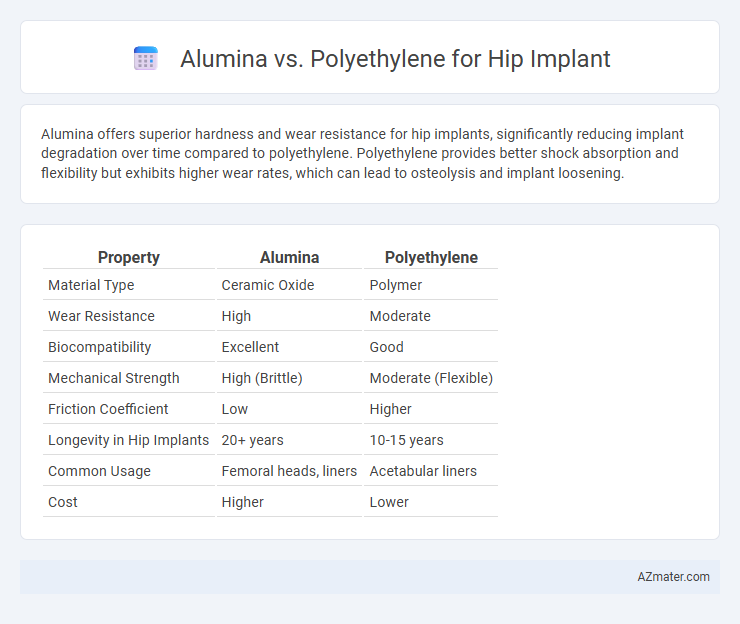Alumina offers superior hardness and wear resistance for hip implants, significantly reducing implant degradation over time compared to polyethylene. Polyethylene provides better shock absorption and flexibility but exhibits higher wear rates, which can lead to osteolysis and implant loosening.
Table of Comparison
| Property | Alumina | Polyethylene |
|---|---|---|
| Material Type | Ceramic Oxide | Polymer |
| Wear Resistance | High | Moderate |
| Biocompatibility | Excellent | Good |
| Mechanical Strength | High (Brittle) | Moderate (Flexible) |
| Friction Coefficient | Low | Higher |
| Longevity in Hip Implants | 20+ years | 10-15 years |
| Common Usage | Femoral heads, liners | Acetabular liners |
| Cost | Higher | Lower |
Introduction to Hip Implant Materials
Hip implant materials primarily include alumina ceramics and ultra-high-molecular-weight polyethylene (UHMWPE), each offering distinct biomechanical properties critical for joint replacement longevity. Alumina provides exceptional hardness, wear resistance, and biocompatibility, reducing debris generation and osteolysis risk. In contrast, polyethylene offers flexibility and shock absorption but is prone to wear and subsequent osteolytic reactions, influencing implant lifespan and revision rates.
Overview of Alumina Ceramics in Hip Implants
Alumina ceramics in hip implants offer exceptional biocompatibility and wear resistance, making them ideal for long-term joint replacement applications. Their high hardness and chemical inertness reduce the risk of ion release and implant degradation compared to polyethylene components. Alumina's superior tribological properties contribute to lower friction and minimal wear debris, enhancing implant longevity and patient outcomes.
Polyethylene as a Hip Implant Material
Polyethylene, specifically ultra-high-molecular-weight polyethylene (UHMWPE), is widely used as a bearing surface in hip implants due to its excellent wear resistance and biocompatibility. Compared to alumina ceramic, polyethylene provides enhanced shock absorption and flexibility, reducing the risk of implant fracture. Advances in highly cross-linked polyethylene have significantly improved its durability and reduced wear particles, making it a preferred choice for long-term hip replacement success.
Mechanical Properties: Alumina vs Polyethylene
Alumina exhibits superior hardness and wear resistance compared to polyethylene, making it highly durable for hip implant applications. Polyethylene offers greater toughness and flexibility, which reduces brittle fracture risk but increases wear particle generation. The combination of alumina's high stiffness with polyethylene's impact absorption balances mechanical performance in hip prostheses.
Wear Resistance and Longevity
Alumina exhibits superior wear resistance compared to polyethylene, significantly reducing particle debris that contributes to osteolysis in hip implants. Its high hardness and biocompatibility enhance the longevity of the implant by maintaining surface integrity under repetitive load cycles. Polyethylene, while more flexible, demonstrates greater wear rates leading to earlier implant revision in long-term orthopedic applications.
Biocompatibility and Biological Response
Alumina ceramics exhibit superior biocompatibility and elicit minimal inflammatory response due to their inert and wear-resistant properties, making them highly suitable for hip implants. Polyethylene, especially ultra-high-molecular-weight polyethylene (UHMWPE), has favorable biocompatibility but can generate wear particles that may trigger adverse biological reactions like osteolysis. The choice between alumina and polyethylene hinges on balancing long-term durability against the potential for biological response-induced implant loosening in total hip arthroplasty.
Clinical Performance and Outcomes
Alumina ceramic hip implants demonstrate superior wear resistance and biocompatibility compared to polyethylene, resulting in lower osteolysis rates and longer implant longevity. Polyethylene liners, while more cost-effective, are prone to wear particle generation that can induce inflammatory responses and implant loosening. Clinical outcomes reveal alumina ceramics offer improved joint stability and reduced revision surgery rates, especially in younger, more active patients.
Risk of Implant Failure and Complications
Alumina hip implants exhibit high wear resistance and biocompatibility, significantly reducing the risk of implant failure due to osteolysis and loosening compared to polyethylene components. Polyethylene, especially conventional types, is prone to wear particle generation, leading to inflammation and increased rates of implant loosening and failure over time. Advances in highly cross-linked polyethylene have improved wear characteristics, but alumina ceramics still outperform polyethylene in minimizing wear-related complications and extending implant longevity.
Cost-Effectiveness and Accessibility
Alumina hip implants generally offer superior wear resistance and longevity but come with higher upfront costs, limiting accessibility in budget-constrained healthcare settings. Polyethylene implants present a more cost-effective alternative with lower initial expenses and wider availability, though they may require more frequent revisions due to wear and degradation over time. Balancing long-term durability against initial affordability is crucial in deciding between alumina and polyethylene materials for hip replacements.
Future Trends in Hip Implant Materials
Future trends in hip implant materials show increasing exploration of hybrid composites combining alumina's high wear resistance and polyethylene's superior elasticity to enhance implant longevity and biocompatibility. Research emphasizes nano-engineered alumina coatings on polyethylene liners to reduce wear particles and osteolysis, addressing common complications in hip arthroplasty. Advances in bioactive surface modifications and additive manufacturing techniques aim to optimize the mechanical properties and integration of alumina-polyethylene composites for next-generation hip implants.

Infographic: Alumina vs Polyethylene for Hip implant
 azmater.com
azmater.com